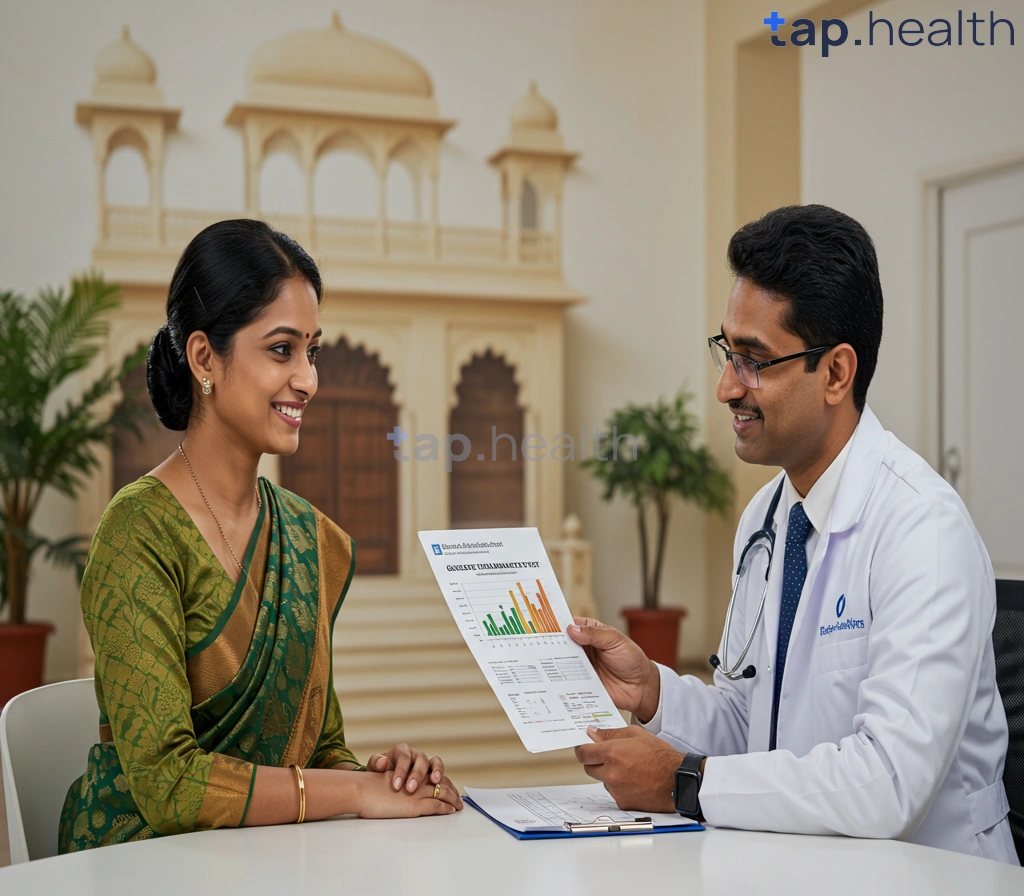Table of Contents
- Understanding Gestational Diabetes: A Complete Guide
- Early Diagnosis & Management of Gestational Diabetes
- Navigating Gestational Diabetes Treatment Options
- Controlling Blood Sugar: Your Gestational Diabetes Plan
- Is it Gestational Diabetes? Symptoms and Diagnosis
- Frequently Asked Questions
- References
Expecting a little one is an exciting time, but for some, the journey is complicated by gestational diabetes. This condition, affecting pregnant individuals, requires careful management to ensure a healthy pregnancy for both mother and baby. Understanding and Managing Gestational Diabetes: Diagnosis and Treatment is crucial, and this blog is designed to provide you with clear, reliable information to navigate this challenge. We’ll cover everything from recognizing the early signs to exploring treatment options and long-term implications. Let’s empower you with the knowledge you need to confidently manage your gestational diabetes.
Understanding Gestational Diabetes: A Complete Guide
What is Gestational Diabetes?
Gestational diabetes (GDM) is a type of diabetes that develops during pregnancy. It’s a significant concern, affecting around 2.5 million women in India every year – and that number is sadly reflective of similar trends in other tropical regions. Essentially, your body isn’t making enough insulin to keep your blood sugar in check. Getting a handle on GDM is crucial for a healthy pregnancy for both you and your baby.
Diagnosis and Risk Factors
Usually, GDM is diagnosed with a glucose tolerance test (GTT) during your second trimester. In India and similar climates, risk factors often include a family history of diabetes, being overweight, a previous GDM pregnancy, and ethnicity. Early detection is key, because uncontrolled GDM can lead to complications like larger-than-average babies, potentially difficult deliveries, and an increased risk of developing type 2 diabetes later in life. And while your family history plays a role, it’s important to remember that GDM does not come from the father – check out this article to clear up that common misconception: Does Gestational Diabetes Come From the Father?
Managing Gestational Diabetes
Managing GDM usually involves a mix of lifestyle changes and, sometimes, medication. Think a balanced diet packed with whole grains, fruits, vegetables, and lean protein. Regular exercise is also essential – even a brisk walk or yoga session can make a big difference and are easily incorporated into many Indian lifestyles. Your doctor might recommend medication if diet and exercise aren’t enough to control your blood sugar.
Post-Pregnancy Care
After you deliver, keeping an eye on your blood sugar is vital. For many, levels return to normal, but regular check-ups are important to assess your risk of developing type 2 diabetes down the line. Sticking to a healthy lifestyle long-term is your best bet for preventing future issues. Talk to your doctor or a certified diabetes educator for personalized guidance. And for more info on managing diabetes later in life, check out our helpful guide: Managing Diabetes as You Age: Challenges and Solutions.
Early Diagnosis & Management of Gestational Diabetes
Understanding Gestational Diabetes in Indian and Tropical Contexts
Gestational diabetes (GDM)—diabetes developing during pregnancy—is becoming increasingly common in India and other tropical regions. Early detection isn’t just vital for mom’s health; it significantly impacts the child’s future. Research shows a staggering seven-fold increased risk of type 2 diabetes in children born to mothers with GDM. This underscores the urgency of proactive management and prevention.
Risk Factors and Early Detection
Several factors raise your risk of GDM, including a family history of diabetes, obesity, previous GDM pregnancies, and ethnicity. Certain Indian ethnic groups, for instance, show a higher predisposition. Regular antenatal check-ups, including glucose tolerance tests (GTTs), are crucial for early diagnosis. These tests are widely available. Knowing what to eat before a GTT—check this helpful guide—ensures accurate results and timely intervention, minimizing long-term health risks.
Effective Management Strategies
Managing GDM often involves a blend of diet, exercise, and sometimes medication. Think of it like this: fuel your body with good stuff! A balanced diet rich in fruits, vegetables, and whole grains is key. Cut back on sugary drinks and processed foods. Regular physical activity, even short walks, helps manage blood sugar levels. Always follow your doctor’s advice on medication. Personalized guidance from a doctor or diabetes educator is invaluable. And remember, knowing what to avoid before a GTT is just as important for accurate results.
Taking Action for a Healthier Future
For expectant mothers in India and tropical areas, proactive GDM management is essential. Regular check-ups, a healthy lifestyle, and careful monitoring throughout pregnancy are vital for a healthy pregnancy and reduce long-term diabetes risks for both you and your baby. Don’t hesitate – talk to your doctor; your health and your baby’s well-being are paramount.
Navigating Gestational Diabetes Treatment Options
Gestational diabetes (GDM)—diabetes diagnosed during pregnancy—affects many women, particularly in regions like India. Managing GDM effectively is vital for a healthy pregnancy and long-term well-being. Let’s explore your options.
Dietary Management: Your First Line of Defense
Dietary changes are usually the first step. Think balanced meals packed with fiber-rich foods like fruits, vegetables, and, in India, wonderful whole grains such as millets. Swap processed foods, sugary drinks, and refined carbs for healthier alternatives. Smaller, more frequent meals help keep blood sugar levels steady. Wondering about pizza? We’ve got you covered! Check out our article: Can I Have Pizza with Gestational Diabetes?
Exercise: Moving Towards a Healthier Pregnancy
Regular physical activity is key. Aim for at least 30 minutes of moderate exercise most days—think brisk walks, yoga, or anything suitable for your fitness level and pregnancy stage. Always consult your doctor first. In warmer climates, early mornings or evenings might be ideal.
Medication: When Lifestyle Isn’t Enough
If diet and exercise aren’t enough to control your blood sugar, your doctor may recommend medication, often insulin. Don’t worry—insulin is safe for both you and your baby. Open communication with your doctor is crucial. Affordable and accessible healthcare is essential; don’t hesitate to seek help.
Long-Term Health: Looking Ahead
Remember, women with GDM have a higher risk of developing heart disease later in life. Post-pregnancy, maintaining a healthy lifestyle and monitoring blood sugar is key to preventing long-term complications. Regular check-ups and following your doctor’s advice are essential. Join support groups, connect with healthcare professionals, and create a personalized plan for your ongoing health. Learn more about your risk of developing diabetes after pregnancy here: Can You Develop Diabetes After Pregnancy?
Controlling Blood Sugar: Your Gestational Diabetes Plan
Gestational diabetes (GDM)—high blood sugar during pregnancy—is more common in India and other tropical countries. Managing it effectively is vital for a healthy pregnancy for both you and your baby. The key? Keeping those blood sugar levels under control.
Dietary Adjustments
Many Indian diets, rich in carbohydrates like rice and chapatis, need some thoughtful tweaks with GDM. Think whole grains instead of refined carbs—swap white rice for brown, for example. Load up on fiber-packed veggies like spinach and lentils, and don’t shy away from healthy fats like avocados or nuts. And remember, portion control is your friend! Smaller, more frequent meals can help keep your blood sugar stable throughout the day. Think five small meals instead of three large ones.
Lifestyle Modifications
Regular exercise is a game-changer. Aim for at least 30 minutes of moderate activity most days—think brisk walks, yoga, or even a swim. In hotter climates, adjust your workout timing to avoid the midday sun. Always chat with your doctor before starting any new exercise program, especially during pregnancy.
Monitoring Blood Sugar
Regular blood glucose monitoring is crucial. It helps you see how your diet and exercise are impacting your levels, allowing for necessary adjustments. Your doctor will guide you on how often to test and what your target range should be. While general diabetes targets are often below 140/90 mmHg, some guidelines suggest aiming even lower, perhaps below 130/80 mmHg. Your doctor will personalize this for you. Understanding your blood sugar levels is key. Learn more about maintaining healthy blood sugar.
Seeking Expert Guidance
Access to healthcare varies, but proactive management is essential. Regular check-ups with your doctor or a diabetologist are non-negotiable throughout your pregnancy. Don’t hesitate to seek support from nutritionists; they can help you create a plan that works for you, considering your cultural background and preferences. Remember, consistent effort in managing GDM greatly improves your pregnancy and minimizes long-term health risks. Effective GDM management can also positively impact other health factors, such as cholesterol. Learn how to manage cholesterol levels with diabetes.
Is It Gestational Diabetes? Symptoms and Diagnosis – Understanding the Risks
Gestational diabetes (GDM) is a type of diabetes that develops during pregnancy. It affects how your body processes sugar and can occur in women of any age, even if you’ve never had diabetes before. In countries like India, GDM is becoming increasingly common. Early detection is crucial to protect both your health and your baby’s health.
Recognizing the Warning Signs
GDM often has no obvious symptoms. In some cases, you might notice:
-
Increased thirst
-
Frequent urination
-
Unexplained weight loss
-
Intense hunger
-
Blurry vision
-
Recurring infections
These are your body’s way of saying it’s under stress. Because symptoms can be mild or absent, regular prenatal checkups are the best way to catch GDM early.
How GDM Is Diagnosed
The glucose tolerance test (GTT) is the standard way to diagnose gestational diabetes.
-
You drink a sweet solution.
-
Blood sugar levels are tested after a set time.
Your doctor will recommend the right time for this test based on your medical history and risk factors. If you live in an area where testing access is limited, discuss options with your healthcare provider early in your pregnancy.
Managing GDM Effectively
If diagnosed early, GDM can be managed successfully through:
-
Healthy eating – Focus on balanced meals with whole grains, local vegetables, and fruits.
-
Regular exercise – Light activities like walking or prenatal yoga.
-
Blood sugar monitoring – Keep track daily or as recommended.
-
Medication – Only if prescribed by your doctor.
Think of it as teamwork – you, your doctor, and a dietitian working together to keep your pregnancy healthy. Support groups can also be helpful.
Note: Gestational diabetes is different from newborn diabetes and other forms of diabetes, such as those that can affect your menstrual cycle. Understanding these differences will help you manage your overall health better.
Frequently Asked Questions on Gestational Diabetes
Q1. What is gestational diabetes, and why is early detection crucial during pregnancy?
Gestational diabetes (GDM) is a type of diabetes that develops during pregnancy, where your body doesn’t produce enough insulin to manage blood sugar. Early detection is crucial because uncontrolled GDM can lead to complications for both mother and baby, including larger-than-average babies, difficult deliveries, and an increased risk of developing type 2 diabetes later in life. It’s particularly important in regions like India where GDM is increasingly common.
Q2. How is gestational diabetes diagnosed, and what are the common risk factors?
GDM is usually diagnosed with a glucose tolerance test (GTT) during the second trimester. Risk factors include family history of diabetes, being overweight or obese, previous GDM pregnancies, and ethnicity. In India and other tropical regions, certain ethnic groups show a higher predisposition. Regular antenatal check-ups are key for early diagnosis.
Q3. What are the common management strategies for gestational diabetes?
Managing GDM typically involves a combination of lifestyle changes and, sometimes, medication. This includes a balanced diet rich in whole grains, fruits, vegetables, and lean protein; regular exercise; and, if necessary, medication prescribed by your doctor. Individualized plans are crucial, taking into account cultural dietary habits.
Q4. What steps should I take after pregnancy to manage my risk of developing type 2 diabetes?
After delivery, it’s vital to monitor your blood sugar levels. While levels often return to normal, regular check-ups are essential to assess your risk of developing type 2 diabetes. Maintaining a healthy lifestyle – balanced diet and regular exercise – is crucial for long-term prevention. Consult your doctor or a certified diabetes educator for personalized guidance.
Q5. What are the common misconceptions about gestational diabetes, and what are the potential long-term health risks?
A common misconception is that gestational diabetes comes from the father; it does not. Women with GDM have an increased risk of developing type 2 diabetes and heart disease later in life. Children born to mothers with GDM have a significantly increased risk of developing type 2 diabetes. Maintaining a healthy lifestyle after pregnancy significantly reduces these risks.
References
- A Practical Guide to Integrated Type 2 Diabetes Care: https://www.hse.ie/eng/services/list/2/primarycare/east-coast-diabetes-service/management-of-type-2-diabetes/diabetes-and-pregnancy/icgp-guide-to-integrated-type-2.pdf
- Diabetes Mellitus: Understanding the Disease, Its Diagnosis, and Management Strategies in Present Scenario: https://www.ajol.info/index.php/ajbr/article/view/283152/266731



